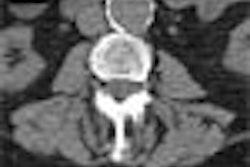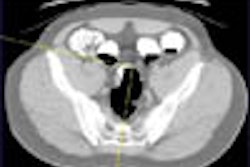The 2002 American Roentgen Ray Society (ARRS) meeting in Atlanta from April 28-May 2 began with an admonition by president Dr. N. Reed Dunnick to the radiology community to bolster its future by supporting research efforts and encouraging fellowships. He also urged private practice imaging and academic radiology to collaborate on projects.
"There is a full spectrum of university departments of radiology, from the highly academic departments with extensive research programs to those that concentrate on teaching and delivering high-quality clinical services. Indeed, some university departments are private-practice groups. In other cases, highly academic departments derive their revenue from patient care. And many private practices sponsor residency training programs and participate in research," Dunnick said in his presidential address.
As one of radiology’s premier general imaging meetings, ARRS covered a variety of topics, modalities, and specialties. For those who specialize in women’s imaging, researchers from the University of Pennsylvania in Philadelphia suggested that a real-time, handheld near-infrared device could offer a simple and noninvasive way to conduct breast cancer imaging. The device relies on diffuse optical tomography, a technology that uses near-infrared light to image areas of the body and creates spatially resolved maps of their optical properties.
From the University of Iowa Hospitals in Iowa City, presenters shared their formal policy on imaging pregnant patients with ionizing radiation.
"Why is such a policy necessary? Imaging women and the risk of fetal exposure are not new issues," said medical student Meghan Blake in her talk. "Yet the imaging tools are radically different than those used several decades ago when these issues were first addressed. The growth of CT technology in particular spurred the development of our policy. While CT is considered a high-dose procedure, delivering between 1-10 rems to the patient, it is also widely coming to be regarded as a first-line imaging modality."
The four-point policy helped the physicians balance the benefits and risks of the exams and enhanced overall communication between patients and doctors.
Researchers from Memorial-Sloan Kettering Cancer Center in New York City found that sonohysterography offered better information about suspected endometrial abnormalities than biopsy. Information provided by sonohysterography could be valuable in planning treatment, particularly if surgery is being considered, said Dr. Cathleen Kim.
On a similar note, a study out of the University of Michigan, Ann Arbor determined that high-resolution ultrasound might reduce the number of breast biopsies by as much as 28% when used to distinguish between benign and malignant solid masses.
In addition, investigators from Sapporo Medical University in Sapporo, Japan recommended that prostate cancer patients, who have a rising PSA level following a radical prostatectomy, should undergo an MRI examination first, not a biopsy, to determine if their cancer has returned.
On the other hand, Korean researchers advocated fine-needle aspiration of thyroid nodules based on positive ultrasound results. In a poster presentation, Dr. Eun-Kyung Kim and colleagues from Yonsei University and Severance Hospital in Seoul, South Korea, outlined new sonographic criteria for fine-needle aspiration biopsy after prospectively reviewing 155 ultrasound scans in 132 patients.
Lowering radiation dose was another hot topic at ARRS. A group from Ghent University in Ghent, Belgium used a digital amorphous-silicon flat-panel detector for routine chest radiography, enabling them to reduce patient radiation dose by three-fourths while still producing clinically acceptable images.
Meanwhile, Dr. James Bell and colleagues from the Vancouver General Hospital in British Columbia slashed CT radiation dose by half and were still able to obtain high-quality images in patients with renal colic. Reducing radiation dose in renal colic patients is particularly important because this group tends to be young and of reproductive age, Bell stated.
Finally, in the area of physician productivity, investigators from the VA Maryland Health System in Baltimore found that even radiologists who lack experience with flat-panel reading of soft-copy chest images are just as comfortable with LCD (liquid-crystal display) monitors as with CRT (cathode-ray tube) displays.
On the honorary front, the ARRS Residents in Radiology Awards went to Dr. Scott B. Reeder, Ph.D., of Stanford University Medical Center in Stanford,CA; Dr. Peter McGraw, a fellow at Duke University Medical Center, Durham, NC; and Dr. Aya Kamaya of the University of Michigan Hospitals in Ann Arbor, MI.
Reeder received the of $2,000 President’s Award for his abstract, "Rapid Imaging of Articular Cartilage with Steady-State Free Precession and Multipoint Fat-Water Separation."
McGraw’s work on the age-related changes in anisotropy between compact and noncompact white matter using tensor diffusion imaging earned him one of two $1,000 Executive Council Awards.
Kamaya took home the second $1,000 Executive Council Award for her abstract "Color Doppler Twinkling Artifact: Its Dependence on Machine Parameters and Its Underlying Cause."
The 2003 ARRS meeting will be held May 4-9 in San Diego, CA.
By Shalmali PalAuntMinnie.com staff writer
June 5, 2002
Related Reading
Experimental infrared imager pinpoints tumor development in breast cancer, July 19, 2002
Flat-panel DR shrinks chest x-ray dose, May 27, 2002
Lowering CT dose yields usable results in renal colic, May 24, 2002
Policy clarifies imaging risks for pregnant women, May 15, 2002
Ultrasound beats biopsy for tamoxifen-related endometrial polyps, May 2, 2002
High-resolution ultrasound may reduce need for breast biopsies, May 2, 2002
Study recommends FNA for all US-detected thyroid nodules, May 1, 2002
LCD just as good as conventional monitors for chest CR, April 30, 2002
ARRS president urges rads to take stock in the future, April 29, 2002
Copyright © 2002 AuntMinnie.com



















